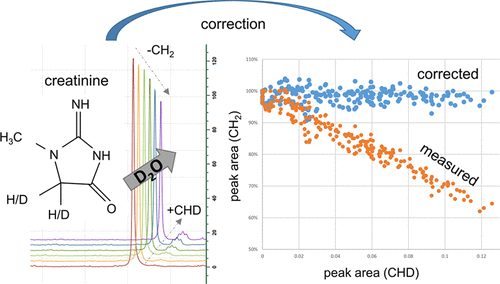当前位置:
X-MOL 学术
›
Anal. Chem.
›
论文详情
Our official English website, www.x-mol.net, welcomes your
feedback! (Note: you will need to create a separate account there.)
Guidelines for the Use of Deuterium Oxide (D2O) in 1H NMR Metabolomics
Analytical Chemistry ( IF 6.7 ) Pub Date : 2019-08-09 00:00:00 , DOI: 10.1021/acs.analchem.9b01580 Kristina Elisa Haslauer 1, 2 , Daniel Hemmler 1, 2 , Philippe Schmitt-Kopplin 1, 2 , Silke Sophie Heinzmann 1
Analytical Chemistry ( IF 6.7 ) Pub Date : 2019-08-09 00:00:00 , DOI: 10.1021/acs.analchem.9b01580 Kristina Elisa Haslauer 1, 2 , Daniel Hemmler 1, 2 , Philippe Schmitt-Kopplin 1, 2 , Silke Sophie Heinzmann 1
Affiliation

|
In metabolomics, nuclear magnetic resonance (NMR) spectroscopy allows to identify and quantify compounds in biological samples. The sample preparation generally requires only few steps; however, an indispensable factor is the addition of a locking substance into the biofluid sample, such as deuterium oxide (D2O). While creatinine loss in pure D2O is well-described, the effects of different D2O concentrations on the signal profile of biological samples are unknown. In this work, we investigated the effect of D2O levels in the NMR buffer system in urine samples, in dependence on dwell time and temperature exposition. We reveal a decrease of the urinary creatinine peak area up to 35% after 24 h of dwell time at room temperature (RT) using 25% (v/v) D2O, but only 4% loss using 2.5% D2O. 1H, inverse-gated (IG) 13C, DEPT-HSQC NMR, and mass spectrometry (MS) experiments confirmed a proton–deuterium (H/D) exchange at the CH2. This leads to underestimation of creatinine levels and has an extensive effect when creatinine is used for normalization. This work offers a sample stability examination, depending on the D2O concentration, dwell time, and temperature and enables a method to correct for the successive loss. We propose an equation to correct the creatinine loss for samples prepared with various D2O concentrations and storage temperatures for dwell times up to 24 h. The correction function was validated against an external data set with n = 26 samples. To ensure sufficient creatinine stability in future studies, we suggest that a maximum of 10% D2O should be used at 4 °C or 2.5% D2O at RT, respectively.
中文翻译:

在1 H NMR代谢组学中使用氧化氘(D 2 O)的准则
在代谢组学中,核磁共振(NMR)光谱可以识别和定量生物样品中的化合物。样品制备通常只需要几个步骤。然而,必不可少的因素是在生物流体样品中添加了锁定物质,例如氧化氘(D 2 O)。尽管对纯D 2 O中肌酐的损失进行了很好的描述,但尚不清楚不同D 2 O浓度对生物样品信号图谱的影响。在这项工作中,我们研究了D 2的作用尿样中NMR缓冲液系统中的O含量取决于停留时间和温度暴露。我们发现在室温(RT)下使用25%(v / v)D 2 O停留24小时后,尿肌酐峰面积减少高达35%,而使用2.5%D 2 O仅减少4%。1 H,逆门控(IG)13 C,DEPT-HSQC NMR和质谱(MS)实验证实了CH 2处的质子-氘(H / D)交换。这会导致肌酐水平的低估,并且当肌酐用于标准化时会产生广泛的影响。这项工作提供了样品稳定性检查,具体取决于D 2O浓度,停留时间和温度,并提供了一种校正连续损失的方法。我们提出了一个方程式,以校正以各种D 2 O浓度和储存温度制备的样品的肌酸酐损失,停留时间长达24小时。校正函数针对n = 26个样本的外部数据集进行了验证。为了确保在未来的研究足够肌酐稳定性,我们建议的最大的10%的d 2 ö应在4使用℃或2.5%d 2分别ø在RT。
更新日期:2019-08-09
中文翻译:

在1 H NMR代谢组学中使用氧化氘(D 2 O)的准则
在代谢组学中,核磁共振(NMR)光谱可以识别和定量生物样品中的化合物。样品制备通常只需要几个步骤。然而,必不可少的因素是在生物流体样品中添加了锁定物质,例如氧化氘(D 2 O)。尽管对纯D 2 O中肌酐的损失进行了很好的描述,但尚不清楚不同D 2 O浓度对生物样品信号图谱的影响。在这项工作中,我们研究了D 2的作用尿样中NMR缓冲液系统中的O含量取决于停留时间和温度暴露。我们发现在室温(RT)下使用25%(v / v)D 2 O停留24小时后,尿肌酐峰面积减少高达35%,而使用2.5%D 2 O仅减少4%。1 H,逆门控(IG)13 C,DEPT-HSQC NMR和质谱(MS)实验证实了CH 2处的质子-氘(H / D)交换。这会导致肌酐水平的低估,并且当肌酐用于标准化时会产生广泛的影响。这项工作提供了样品稳定性检查,具体取决于D 2O浓度,停留时间和温度,并提供了一种校正连续损失的方法。我们提出了一个方程式,以校正以各种D 2 O浓度和储存温度制备的样品的肌酸酐损失,停留时间长达24小时。校正函数针对n = 26个样本的外部数据集进行了验证。为了确保在未来的研究足够肌酐稳定性,我们建议的最大的10%的d 2 ö应在4使用℃或2.5%d 2分别ø在RT。


















































 京公网安备 11010802027423号
京公网安备 11010802027423号